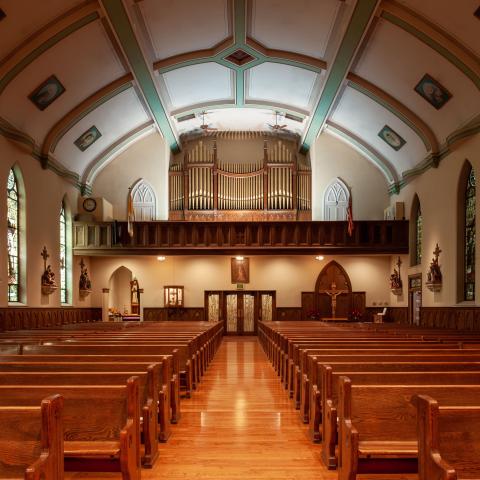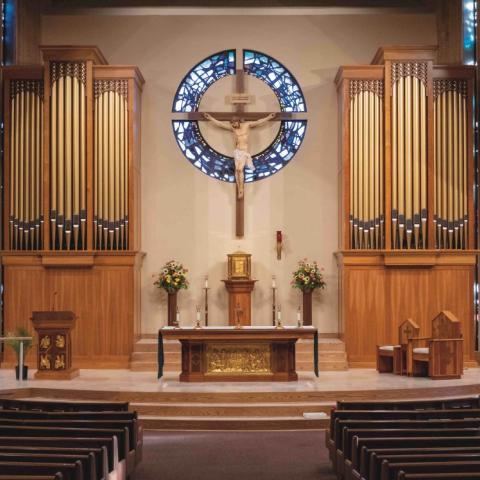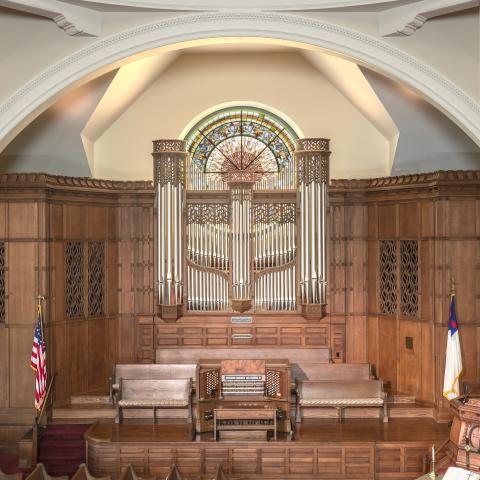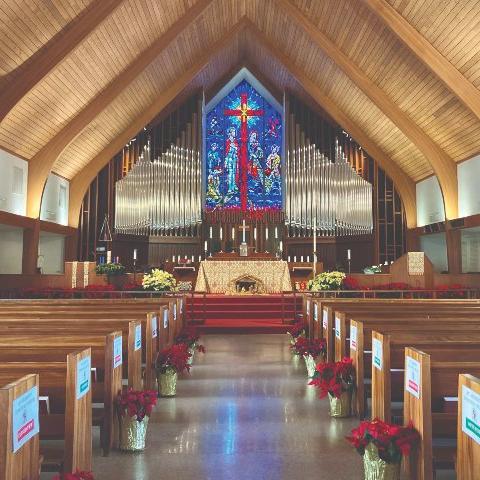Muller Pipe Organ Company, Croton, Ohio; Gay Street United Methodist Church, Mount Vernon, Ohio
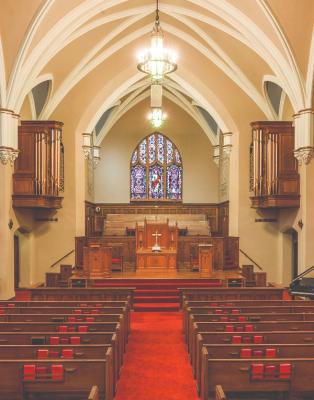
Muller Pipe Organ Company, Croton, Ohio; Gay Street United Methodist Church, Mount Vernon, Ohio
Gay Street United Methodist Church reached out to our company for help with their failing pipe organ in 2000, shortly after I began working for Muller. Dr. David Tovey, director of music at the time, wanted ideas for a solution. The ensuing process did not occur in a straight-line manner but through directed and creative steps over the course of more than twenty years, resulting in a unique and colorful instrument with a storied history in its own right—truly a tale of Ohio organ building!
Votteler-Holtkamp-Sparling’s organ for Gay Street Church
The 1927 Votteler-Holtkamp-Sparling (VHS) was a modest three-manual organ of twenty-five ranks, utilizing pipework dating from the previous 1886 A. B. Felgemaker instrument, but on an entirely new mechanism. Installed in two chambers on either side of the choir at the front of the church, the VHS had a gentle presence. Tonally, it was as one might expect, with a plethora of flutes and strings but not much in the way of choruses.
Henry Holtkamp was an innovator and created a stop called “Ludwig’s Tone,” an open flute, essentially two pipes in one, tuned as a celeste. This delightful stop, copied by later builders, has been retained and incorporated into the new organ’s design.
The VHS organ served the church for decades. It was substantially enlarged and reconditioned in the 1970s and again in the 1990s by a local company. As part of that work, the Great division was brought out of the chambers on visually functional windchests and placed on the walls immediately in front of the organ.
Myriad problems became apparent after the 1990s project. Too many stopknobs had been placed in the art-deco console, and restoration of the ventil windchests was unsuccessful. The organ suffered greatly during the winter, resulting in ciphers and silent stops. Despite the incongruent tonal additions, a general sense of the VHS survived but not enough to guide a successful restoration.
Walter Holtkamp, Sr.’s organ for Christ Church, Cincinnati
In 1957 the successor firm to VHS installed Job No. 1695 in the newly constructed Christ Episcopal Church, Cincinnati. At sixty-eight ranks, five divisions, and three manuals, it was one of the later and larger instruments built by the Holtkamp Organ Company under the supervision of Walter Holtkamp, Sr.
This organ could not be more different from Gay Street Church’s 1927 instrument, although likely some of the same hands and tools produced it. The Christ Church organ possessed well-developed, clean and clear choruses and aggressive European style reeds, with all pipes visible and arranged by division in a side gallery.
The organ rose to prominence under the hands of Gerre Hancock, who began his professional career at Christ Church. It was often recorded, and for a time was the preferred instrument for recitals and masterclasses for students of Cincinnati Conservatory of Music. Christ Church was consecrated the cathedral church of the Episcopal Diocese of Southern Ohio in 1998, and the building was extensively renovated the following year.
Time had taken its toll. The organ’s unique tonal aesthetic had gone out of fashion, and its mechanism stood in need of extensive restoration. Renovations to the church had created some unfortunate acoustical issues. Although improving the sound of the choir, the organ became acoustically too far removed from choral forces to effectively provide accompaniment and support. In 2020 it was replaced by Richards, Fowkes & Co.’s Opus 24. (See cover feature, May 2021.)
A relocated Holtkamp for Gay Street Church?
Various options to improve the organ were considered when Muller assumed its care at Gay Street Church, but church leaders opted to keep the instrument working as best it could for as long as possible because of the recent renovations. As it declined, various steps were taken to improve playability.
The most important project was refurbishment of the unique VHS console. This presented a challenge since the cabinet was too small for the number of drawknobs needed. Jack Muller, then our principal cabinetmaker (currently shop foreman and project manager), carefully examined the console and suggested a creative approach to save the cabinet. To accommodate larger stopjambs, we increased the overall width of the console by constructing a new center panel with replica carvings. The cabinet was fitted with a new top, refinished, and all other components replaced.
Still, the problems eventually became untenable. Various options were explored, and finally the decision was made to use the resources of the Christ Church Holtkamp to create an entirely new tonal scheme.
One might ask why not relocate the Holtkamp as it was? As a historic instrument by an important American builder, aren’t we discarding history? The reality is that the organ as it was known at Christ Church could only exist there or in a similar space in an uncased aesthetic. Otherwise, it would not exist as a “Walter Holtkamp, Sr.” signature instrument.
An opportunity for relocating the organ did not materialize over the several years it was available for purchase. The cathedral needed it removed to begin renovations in preparation for the new organ. If a new home could not be found for the instrument, it would be discarded or broken up for parts. At the final hour, the Holtkamp was saved from destruction and donated to Gay Street Church by a longtime admirer of the instrument. Because any organ at Gay Street Church would be mostly chambered, we knew we would need to use the Holtkamp pipework carefully for the project to be successful.
A “new” Muller organ for Gay Street Church
Our new organ for Gay Street Church is three manuals and forty ranks and makes use of pipework from both the VHS and Holtkamp organs in a completely new tonal scheme. The electro-pneumatic mechanism and casework of the organ are new, and the recently updated console is retained.
Custom-built, quartersawn oak cases were designed to house the Great division and some Pedal pipework, including a façade of Great and Pedal principal pipes. The mirrored cases are placed on either side of the chancel, facing each other. Well into the project, the design of the casework had to be modified; structural analysis found that the church walls are soft clay tiles, necessitating the installation of a robust steel support structure. The casework was widened, and smaller “wings” were constructed to accommodate these changes.
The Great chorus is independent and complete from 8′ Principal to IV Mixture. An 8′ Bourdon and 4′ Spire Flute complete the division’s independent stops, while the Open Flute and Gemshorn are borrowed from the Choir division for flexibility. The Pedal Principal is located in the casework, while the 16′ Bourdon and Trombone are located in a chamber immediately behind.
The Swell division returns to the chamber of the VHS Swell organ. Tonally, the hand of Walter Holtkamp, Sr., is apparent, with the Swell division’s specification largely intact from the Christ Church organ. An independent chorus is here, a foil to the larger chorus in the Great, as is an abundance of string and flute color. Other hands are also apparent; new English-style reeds color the division, a 4′ Principal replaces Holtkamp’s 4′ Gemshorn, and the Harmonic Flute and Vox Humana of the VHS organ are retained to provide different colors.
The Choir division is in the chamber that originally housed the VHS Great, Choir, and Pedal. Using available resources in a new scheme, the design of this division is where our tonal signature becomes obvious. An Open Flute is the workhorse of the division, with a Gemshorn and Celeste as the “main strings.” The Gemshorn is extended to 16′ for use on the Great division. VHS’s “Ludwig’s Tone” returns to the division (renamed the more common Ludwigtone) as a secondary undulating stop. A tertiary principal chorus exists here, as do various mutations and flutes. A lovely vintage 8′ Clarinet rounds out the specification, and a new 8′ Festival Trumpet provides the triumphant culmination of the full organ’s sound.
Ordinarily when specifying a three-manual organ of this size, we prefer a more substantial and independent Pedal division. Indeed, I suspect that Holtkamp, Sr., would have chastised us for only providing three ranks! The reality of space precluded this, as did the wish to have as much color throughout the manual divisions as possible. Complemented by judicious use of digital 16′ and 32′ stops, these three stops are the most important in any Pedal division, and certainly provide the independence desired.
So, what kind of organ is this? Is it a Muller? Is it a VHS? Is it a Holtkamp, Sr.? I suppose it is representative of Muller, though it is not the organ we would design if built completely from scratch. The new organ is classically American and represents the work of three important Ohio organbuilders of different eras, brought into cohesiveness and harmony through intelligent and artistic voicing, traditional and well-designed mechanics, and a touch of happenstance that brought it all together.
The new organ was dedicated during worship on December 3, 2023, and an inaugural concert was presented on May 19, 2024. We are honored to be a small part of the longstanding musical heritage at Gay Street United Methodist Church and sincerely thank the many people who worked with us over the years. It is because of their persistence and uncompromising commitment to excellence that this organ will continue to sing praises for generations to come.
—Scott G. Hayes
Scott G. Hayes is the tonal director for Muller Pipe Organ Company and has been with the firm for nearly twenty-five years. He is also director of music at All Saints Episcopal Church in Richmond, Virginia.
Muller staff
John W. Muller
Jack Muller
Scott G. Hayes
Brad Ashbrook
Ryan J. Boyle
Jesse Braswell
Taylor Hendershott
Mike Hric
Ryan Jones
Jane Muller
Stan Osborn
Sol Rizzato
Assisted by: David R. Beck
Photo credits: Jesse Braswell
Builder’s website: www.mullerpipeorgan.com/
GREAT
16′ Gemshorn (Ch, 1–12 digital)
8′ Principal* 61 pipes
8′ Gemshorn (Ch)
8′ Open Flute (Ch)
8′ Bourdon* 61 pipes
4′ Octave* 61 pipes
4′ Spire Flute* 61 pipes
2′ Super Octave* 61 pipes
IV Mixture* 244 pipes
8′ Tromba (Ped)
8′ Festival Trumpet (Ch)
Zimbelstern
Great 16, UO, 4
SWELL (expressive)
16′ Chimney Flute 73 pipes
8′ Geigen Principal* 61 pipes
8′ Chimney Flute (ext 16′)
8′ Gambe* 61 pipes
8′ Voix Celeste* (TC) 49 pipes
4′ Principal 61 pipes
4′ Harmonic Flute§ 61 pipes
2-2/3′ Quint* 61 pipes
2′ Doublette* 61 pipes
III Mixture* 183 pipes
16′ Bassoon 73 pipes
8′ Trumpet 73 pipes
8′ Oboe (ext 16′)
8′ Vox Humana§ 61 pipes
4′ Clarion (ext 8′)
Tremulant
Swell 16, UO, 4
CHOIR (expressive)
8′ Open Flute* 61 pipes
8′ Gemshorn* 61 pipes
8′ Gemshorn Celeste* (TC) 49 pipes
8′ Ludwigtone§ 49 pipes
4′ Principal* 61 pipes
4′ Chimney Flute* 61 pipes
2-2/3′ Nazard* 61 pipes
2′ Flute* 61 pipes
1-3/5′ Tierce* 61 pipes
III Mixture* 183 pipes
8′ Clarinet 61 pipes
8′ Festival Trumpet 61 pipes
Chimes (digital)
Harp (digital)
Tremulant
Choir 16, UO, 4
PEDAL
32′ Bourdon (digital)
16′ Open Wood (digital)
16′ Bourdon* 44 pipes
16′ Chimney Flute (Sw)
16′ Gemshorn (Ch, 1–12 digital)
8′ Principal* 44 pipes
8′ Bourdon (ext 16′)
8′ Chimney Flute (Sw)
8′ Gemshorn (Ch)
4′ Choral Bass (ext 8′)
4′ Open Flute (Ch)
32′ Trombone (digital)
16′ Trombone 73 pipes
16′ Bassoon (Sw)
8′ Tromba (ext)
4′ Oboe (Sw)
8′ Festival Trumpet (Ch)
* Holtkamp
§ Votteler-Holtkamp-Sparling
Couplers
Great to Pedal 8, 4
Swell to Pedal 8, 4
Choir to Pedal 8, 4
Swell to Great 16, 8, 4
Choir to Great 16, 8, 4
Swell to Choir 16, 8, 4
Thumb Pistons
General 1–10
Swell 1–8
Great 1–8
Choir 1–8
Swell to Pedal reversible
Great to Pedal reversible
Choir to Pedal reversible
Next
Previous
Set
Cancel
Toe Pistons
General 1–10
Pedal 1–5
Swell to Pedal reversible
Great to Pedal reversible
Choir to Pedal reversible
Zimbelstern reversible
32′ Bourdon reversible
32′ Trombone reversible
Next
Wind Pressures
Great: 3.5′′
Swell: 5′′
Choir: 5′′
Pedal: 4′′
Festival Trumpet: 7′′
40 ranks
2,418 pipes

